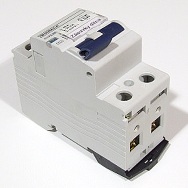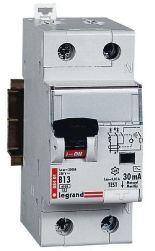Categories: Electrician Secrets, Electrician at home, Automata and RCD
Number of views: 156926
Comments on the article: 21
RCD - causes of operation and how to deal with it
 RCD - residual current device. Many probably heard, but someone probably knows what this device is, what it is for and how it works. Without really going into the jungle of physics, we will briefly try to understand the device, the principles of this RCD simple human language.
RCD - residual current device. Many probably heard, but someone probably knows what this device is, what it is for and how it works. Without really going into the jungle of physics, we will briefly try to understand the device, the principles of this RCD simple human language.
So, as the name implies, This device is designed to protect against electric shock.. The principle of operation of the device is based on a comparison of currents along the conductors at the input and output of the device. The currents must be equal. If there is a slight difference, the device “sees” it and immediately disconnects the load from the network. The response time, by standards, should be no more than 15-25 ms.
For example, if there is a breakdown of insulation on the case, and it doesn’t matter if it is a phase wire or zero, in any case, when a person touches the case of the device, current leak through the human body, to which the RCD will immediately respond and turn off the damaged device, thereby saving a person’s life. Here is perhaps the simplest and most understandable example for a person who is far from physics.

Now, in fact, we begin to review the reasons due to which, in practice, the operation of RCDs occurs.
As we found out earlier, RCD trips when current leakage occurs. Cracks in the insulation of worn wires in older buildings can cause this leak. In this case, the operation of the protection prevents the occurrence of a fire.
What to do in this case? The only answer is look for possible leakage currents. You can, of course, get by with simpler methods, for example, simply exclude RCDs from the circuit, but no one knows what this will lead to.
Posting can last for more than a decade, and can lead to misfortune. And electricity, as you know, does not like jokes and does not forgive negligence.
In addition to wire wear, the operation of an RCD often causes wear, and, accordingly, a breakdown of insulation in household appliances. For example, sometimes the cause of the operation of an RCD can be old refrigerators, washing machines, etc.
Sometimes, in 50% of cases, manipulation of the plug and socket helps to get rid of the RCD operation, that is, just turn the plug in the socket.
 Recently, at the request of RES, after the meter, i.e. a counter, in private houses, apartments, an RCD is installed on the entire house, apartment, with a trip current of 100 mA.
Recently, at the request of RES, after the meter, i.e. a counter, in private houses, apartments, an RCD is installed on the entire house, apartment, with a trip current of 100 mA.
As a rule, if everything is in order with the wiring, the protection does not work, if somewhere there is a current leakage with a total of more than 100 mA, the RCD will let you know.
How to determine where this leak is? First, turn off all appliances. If the problem is not in the devices, you will have to take on the wiring.
If the wiring in the house, apartment is new and done correctly, that is, divided into groups, circuit breakers are installed, the task is greatly simplified. In order to determine the possible location of the malfunction, turn off all the machines, then turn them on one by one. The group that is faulty will make itself felt. Well, then a matter of technology.
 Having found out the faulty group, begin the audit of sockets, lamps, dose boxes. The most common cause is insulation breakdown or incorrect electrical wiring, sockets, fixtures.
Having found out the faulty group, begin the audit of sockets, lamps, dose boxes. The most common cause is insulation breakdown or incorrect electrical wiring, sockets, fixtures.
Sometimes some unfortunate electricians combine ground and zero in the sockets themselves, supposedly to protect against electric shock, anyway, they say, in a switchboard or substation, zero connects to the ground. And this is strictly forbidden to do.
I would also like to note that RCD is not protection against overcurrents and short circuit. It, RCD, simply reacts to the leakage of currents. Many electricians, strangely enough, do not know this, and I can easily put a simple RCD instead of an automatic machine.
In order to protect devices and wires from overload, it is necessary after an RCD to put an automatic machine of the corresponding rating or install a differential automatic machine.
Differential machine- These are two devices in one - RCD and automatic. In any case, so that there are no problems with electricity, trust professionals.
For a more specific case of diagnosing an RCD trip, see here: What to do if an RCD or a difavtomat works when connecting an electric stove or washing machine.
Video on the topic. The RCD can also be disabled if the connection is incorrect. The reasons for the operation of the RCD are installation errors. Major errors are covered in this video.
See also at bgv.electricianexp.com
:
